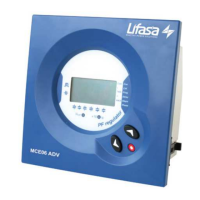
Do you have a question about the Lifasa MCE06ADV and is the answer not in the manual?
| Brand | Lifasa |
|---|---|
| Model | MCE06ADV |
| Category | Controller |
| Language | English |
Checks for transport damage and correct equipment type upon unpacking.
Displays device version code upon initial power-up for error reporting.
Provides definitions for key terms like FCP, stages, and steps used in the manual.
Highlights FCP regulation, switching programs, four quadrants control, LCD display, and ease of setup.
Details the LCD screen, icons, and indications for regulator status and measurements.
Lists parameters like cosφ, current, THD, and voltage displayed during RUN mode.
Explains error codes displayed on the screen and their possible causes.
Describes the function of the alarm relay, typically relay 6 or 12, for error conditions.
Explains the two operating modes (RUN and SET-UP) and key functions for each, including manual control.
Summarizes technical specifications like supply voltage, current limits, precision, and standards.
Covers mechanical mounting, electrical connections, cabling, protections, and wiring schematics for the device.
Sets the desired power factor target for automatic compensation, adjustable from 0.85 inductive to 0.95 capacitive.
Defines the C/K parameter, representing reactive current of the smallest capacitor step, based on CT ratio and supply voltage.
Provides formulas and an example for calculating the C/K parameter for non-standard conditions.
Allows setting capacitor stage power relationships, e.g., 1:1:1 or 1:2:2, for optimal compensation.
Configures delay times for stage connection (Tc) and re-connection (Tr) to manage capacitor switching.
Allows selection of the total number of capacitor stages (up to 6 for MCE06ADV, 12 for MCE12ADV).
Adapts the regulator to different voltage/current measurement configurations using phase shift options T1-T6.
Sets the primary current rating of the external CT for accurate current measurement and regulation.
Explains the procedure to enter the set-up mode by pressing a specific key for an extended duration.
Illustrates the menu structure and key presses for navigating parameters and making adjustments.
Describes manual stage control, parameter measurement display, and clearing max values during operation.
Details how the device reacts to errors, displaying codes and potentially disconnecting stages.